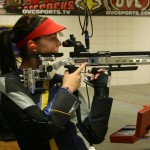Kyra Ledbetter
Staff writer

With 120 shots for a single shooter over the course of a match, it’s hard to imagine a single pull of the trigger as a small eternity of its own. However, for members of the Racer rifle team and their competition, a single shot contains microcosms of technique.
“You have to mentally prepare before you even touch the gun,” Kelsey Emme, freshman shooter, said. “For some people it’s having that one thought going through their heads that keeps them in focus. Sometimes people go step by step through their position before getting (to the match).”
She’s down to standing, her prone (laying down) and kneeling positions having been a little down from her best, but still salvageable. Still OK. With less than 20 shots left the fact that she’s biting her bottom lip and her fingers look tense even before she lifts her gun says, though her score might not, she’s frustrated. On the other side of the glass, which separates spectator and shooter, it becomes apparent. On the electronic monitor showing her shot pattern her most recent shot blazes red on the cluster of previous shots marked in yellow and is less than she’d hoped for. She’s had a series of shots far too close to good for her taste: 9.9, 9.8, 9.9 on a scale where 10.9 is perfection. She sighs and adjusts her visor then the blue and gold ribbons tying back her hair.
“You’re right there,” she thinks to herself. “You’re right there. Just keep doing what you’re doing. You’re fine.” The song that’s been beating quietly in the back of her mind fades as she focuses every bit of her capacities, at shooting a 10.
She looks up, planting her right foot then shifting her hips so she’s nearly parallel to the line she centered herself on. She picks up her gun, nearly like a limb to her now. She presses her face against the metal cheek piece, lowers her gun and pulls the stock back by three fingers. Gripping hard, she consciously relaxes her right shoulder and then her left arm. Her eyes close, and she visibly relaxes and lets her frustration go as best she can. She releases a long, slow exhale and then opens her eyes again. She shifts slightly to the left, pulls her right leg back by no more than an inch and then moves her toes only slightly, adjusting her balance.
She inhales, taking as long as she needs, then exhales and is entirely still. She squeezes the trigger and for a moment or two after, she doesn’t move.
“Afterward I usually analyze if that shot was a good shot or a bad shot, or rather if it was a mentally and technically perfect shot,” senior Ashley Rose said. “If it was a perfect shot then I have nothing to be upset about. When I say perfect shot I mean going through that checklist of body contact spots and mentally executing the shot perfectly. Even if it was a nine and I felt like that shot was good and in my mind it should have been a 10, then it’s a good shot. If I didn’t do those things then I don’t consider it a good shot.”
Then she clears her head, picks up the gun and does it all over again, 119 more times.
Contact Ledbetter